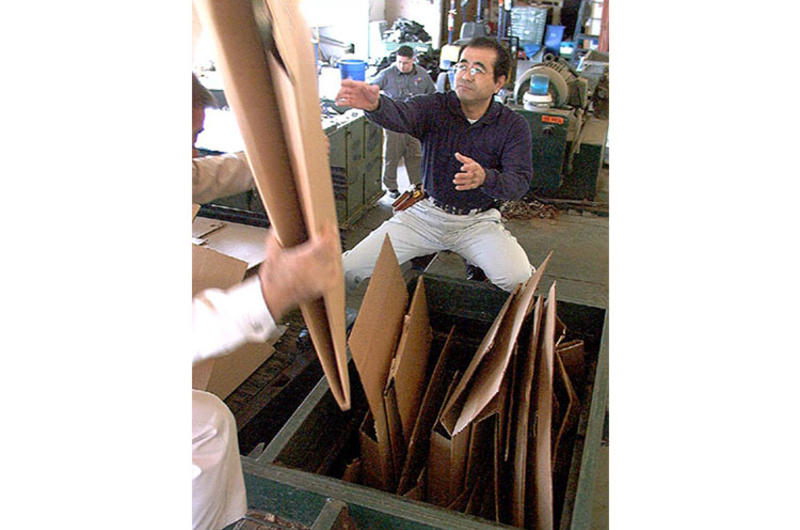As Okinawa landfill space dwindles, recycling is urged

Customer Shinobu Sashida helps load a compactor that scrunches cardboard boxes into 1,100-pound recyclable bales. U.S. military base residents on Okinawa are required to recycle in the face of shrinking landfill space.
By Carlos Bongioanni | Stars and Stripes February 6, 2003
KADENA AIR BASE, Okinawa — In two years, Okinawa could run out of landfill space for trash disposal, military officials warned last week. The prognosis has base leaders urging residents to recycle.
Only six landfill sites remain on the island, said Bruce Whisenhunt, recycling director for the Marine Corps on Okinawa. One near Camp Schwab, at the island’s northern end, closed recently. Four others should close within two years — or may last longer, “based on how well we recycle,” he said.
Once landfills reach their capacity, the only option will be to ship the trash elsewhere, unless officials come up with some other means of disposal, said Whisenhunt. “That’s the dilemma we’re in. … When we have to barge our trash someplace else, who’s going to pay the bill?”
Okinawa legislation forbids creating new landfills, said Kenichi Gima, executive director of Kurashiki Environment Co., a trash disposal and recycling service. Gima said the island’s environmentally conscious residents oppose landfills, which makes creating new ones almost impossible.
Gima’s company manages a large site a few miles east of Kadena’s Gate 3. The landfill — which handles Kadena’s trash — should be full in a year or two, he said. U.S. and Japanese government officials have yet to work out a solution.
Kadena officials issued a memorandum in late January alerting base residents to the situation. Refuse from military family housing represents an “ever-increasing portion” of Okinawa’s waste, the notice stated.
Landfills are ugly but necessary, said Richard Kuehn, chief of service contracts for Kadena’s 18th Civil Engineering Squadron.
“We live on an island of limited land mass with a large number of people,” he said. “We cannot indefinitely amass trash without running out of room and we’re rapidly running out of room.”
At roughly 5 cents per pound, Kadena pays $2 million per year to dispose of 21,416 tons of trash — much of it from military family housing areas throughout the island, said Wayne Cooper, maintenance engineer flight chief with Kadena’s 18th CES.
Increased recycling would generate less trash, helping conserve landfill space, Cooper said — consequently paring disposal costs.
Since 1999, regulations have mandated that all personnel living in military family housing must recycle, said Wendy Hively, Kadena’s environmental program manager.
But participation has been minimal, acknowledged Hively, who oversees the base’s recycling program: “We don’t have any way to enforce it.”
The base notified residents two years ago of their recycling responsibilities, but few people know of the program, she said.
Josh Bass, a Kadena’s Recycling Center material handler, said about 10 percent of Kadena’s residents recycle. If the base had 100 percent compliance, the center would need about nine times more people to handle the workload, he said. He added that base facilities and retail outlets do better at recycling than residents.
On average, Whisenhunt said, 15 percent of residents on Marine Corps bases recycle. He said in recycling rates in Camp Foster housing range from less than 1 percent in an enlisted area to 35 percent in an officer area.
In 2001, military recycling centers collected 2,800 tons of recyclable items that were resold, donated or given away at no cost to the military. For 2002, the centers collected more than 3,000 tons, said Whisenhunt. In December alone, the military on Okinawa saved $29,000 in disposal costs, said Whisenhunt.
That people learn not only to recycle but to separate burnable and non-burnable items is crucial, Gima said. This spring, his company is to complete building a new incinerator and kiln that turns incinerator ashes to construction materials while emitting no environmentally hazardous substances.
“This will greatly help reduce the waste,” he said; if the incinerator operates as planned, “waste which had been buried in the landfill will also be burnt. This way, we can use the landfill for a longer period.”
Okinawa now has one incinerator, which burns pallets to make electricity. It already operates at full capacity.
--------------------------------------------------------------------------------------------------------------
Recycling tips
Three easy steps to recycling for military family housing on Okinawa:
Step 1: Identify and prepare recyclables:
- Rinse all cans and bottles
- Remove all metal caps from bottles
- Remove labels from cans
Step 2: Sort into groups:
- Glass
- Metal cans
- Magazines
- Newspapers
- White paper
- Brown paper bags
Step 3: Take out to the curb:
- Bring recycling bin out to the curb on respective days that pickup crews go through various housing areas on assigned days.
- To learn pickup dates, call Kadena’s Recycling Center at 634-2833.



